
The Chiavari chair, also known as the Chiavarina, or Tiffany chair, is a wooden chair of Ligurian design. [1]

The Chiavari chair, also known as the Chiavarina, or Tiffany chair, is a wooden chair of Ligurian design. [1]
The Chiavarina was created in 1807 by a cabinetmaker from Chiavari on the northwestern Italian coast, Giuseppe Gaetano Descalzi. At the invitation of the President of the Economic Society of Chiavari, the Marquis Stefano Rivarola, Descalzi reworked some chairs in the French Empire style, simplifying the decorative elements and lightening the structural elements. [1]
The chair was a success and soon many factories opened in Chiavari and surrounding towns. When Gaetano Descalzi died in 1855, about 600 workers were making Chiavari chairs. [2] The chair was praised by Charles Albert of Savoy, Napoleon III, [3] and by the sculptor Antonio Canova. [4]
The success of the Chiavarina declined following the introduction of the Austrian chairs of Michael Thonet which were mass-produced, less expensive, and consisting of few elements easily assembled, and in the second half of the twentieth century, following competition from industrial production. The architect and designer Gio Ponti was inspired by the structural system of the Chiavari chair for his Superleggera chair of 1955. [5]

The chair is designed with each component made for the specific stresses it will carry. Descalzi designed a slot system for the construction and a system to tie the strips of the purple willow which form the seat of the chair directly to the frame. [5]
The timbers originally used by Descalzi were wild cherry and maple, which were added to beech and ash, all of them from inland forests in Italy.

Chiavari is a comune (municipality) in the Metropolitan City of Genoa, in Italy. It has about 28,000 inhabitants. It is situated near the river Entella.

Giovanni Andrea Ansaldo was an Italian painter active mainly in Genoa.

Carlo Giuseppe Ratti (1737–1795) was an Italian art biographer and painter of the late-Baroque period. He was a pupil of the painter Giovanni Agostino Ratti. Born in Savona, he moved to Rome where he befriended Anton Raphael Mengs and Pompeo Batoni. He died in Genoa, where he labored for many years.

Antonio Randa was an Italian painter of the classicist period, active in Ferrara, Modena, Rovigo, Florence, Comacchio and his native Bologna.

The Diocese of Chiavari is a Roman Catholic ecclesiastical territory in Liguria, northern Italy. It was created on 3 December 1892 by Pope Leo XIII in the Bull Romani Pontifices. It is a suffragan of the Archdiocese of Genoa.

The Delle Piane family is an old Genoese noble family first recorded in Polcevera in 1121. Over the past ten centuries it has produced many distinguished government officials, clerics, diplomats, soldiers and patrons.
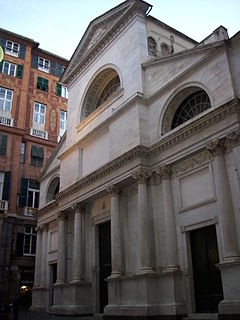
Santa Maria delle Vigne is a Roman Catholic basilica church in Genoa, Italy. It was built in the 10th century. The main altar was completed in 1730 by Giacomo Antonio Ponsonelli. The church is also the final resting place of the leading early Italian composer Alessandro Stradella, who was murdered in 1682.

Pozzo Ardizzi surname comes from the city of Vigevano province of Pavia, Italy, which was formed around the middle of the fifteenth century from a branch of the family that is separated from the noble surname Ardizzi.

The art collections of Fondazione Cariplo are a gallery of artworks with a significant historical and artistic value owned by Fondazione Cariplo in Italy. It consists of 767 paintings, 116 sculptures, 51 objects and furnishings dating from the 1st century to the second half of the 20th century.
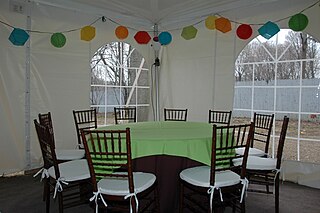
Giuseppe Gaetano Descalzi (1767-1855) was a Genoese furniture maker, best known as the inventor of the Chiavari chair.
Paolo Brescia is an Italian architect and founder of OBR Open Building Research. He graduated with a degree in architecture from the Politecnico di Milano in 1996 and had his academic fellowship at Architectural Association in London. After working with Renzo Piano, he founded in 2000 OBR with Tommaso Principi to investigate new ways of contemporary living, creating a design network among Milan, London, Mumbai and New York. He combines his professional experience with the academic world as guest lecturer in several athenaeums, such as Accademia di Architettura di Mendrisio, Kent State University, Aalto University, University of Oulu, Academy of Architecture of Mumbai, College of Architecture of Pune, Mimar Sinan Fine Art University, Hacettepe University, Florida International University in Miami. He was university professor in charge at Politecnico di Milano (2004-2005) and University of Genoa (2013-2015). With OBR his projects have been featured in international exhibitions, including at X Biennale di Architettura in Venice 2006; RIBA Royal Institute of British Architects in London 2007; V Bienal de Arquitetura in Brasilia 2007; XI Bienal Internacional de Arquitectura in Buenos Aires 2007; AR Award Exhibition in Berlin 2008; China International Architectural Expo in Beijing 2009; International Expo in Shangai 2010; UIA 24th World Congress of Architecture in Tokyo 2011; Energy at MAXXI in Rome 2013; Italy Now in Bogotá 2014; Small Utopias in Johannesburg 2014; XIV Biennale di Architettura in Venice 2014; Triennale di Milano in Milan 2015 and Cooper Hewitt Smithsonian Design Museum in New York 2016.

The AMT Genova, formally known as the Azienda Mobilità e Trasporti and formerly as the Azienda Municipalizzata Trasporti, is a joint stock company that holds the concession for public transport in the Italian city of Genoa.
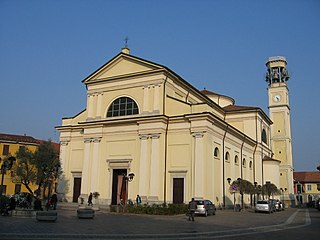
The Church of Saint Bartholomew is the cathedral and the oldest parish in Brugherio, Italy. It houses relics of the three Magi. It is characterised by its relatively high bell tower measuring 36.8 metres (121 ft).
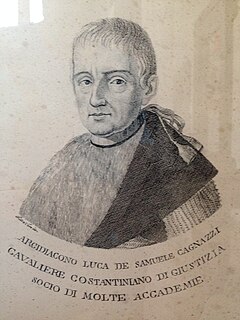
Luca de Samuele Cagnazzi was an Italian archdeacon, scientist, mathematician, political economist. He also wrote a book about pedagogy and invented the tonograph.

Ottavio Serena was an Italian politician, judge, prefect and historian. He is known in his hometown Altamura for his works about local history, such as the Altamuran Revolution (1799). His contribution and the testimonies he collected allowed to shed light on some historical events (such as the killing of Giovanni Firrao and on legendary toponyms.
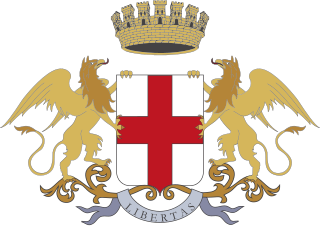
Giuseppe Maria Doria was a Genoese nobleman, elected 183rd Doge of the Republic of Genoa. He was the last member of the house Doria to serve in that office.

Eugenio Gerli was an Italian architect and designer. In an intense working life spanning more than six decades, Eugenio Gerli explored many different areas of his profession. He built villas, apartment blocks, office blocks, factories, banks and stores, and also restored historic buildings. He often completed his works with custom-made interiors and furniture.This diverse range of projects inspired his industrial design and today many have become icons, like the S83 chair, the PS 142 armchair Clamis, the Jamaica cabinet and the Graphis System.

Gustavo Frizzoni was an Italian art critic and art historian.
Ezia Gavazza was an Italian art historian. Along with her friends and colleagues Lauro Magnani and Piero Boccardo, she was one of the most prolific writers in Genoa on Baroque art. She specialised in the Ligurian Baroque, particularly Domenico Piola, Giulio Benso, Giovanni Andrea Ansaldo, Grechetto and Bernardo Strozzi.
Marcello Baschenis was an Italian painter.